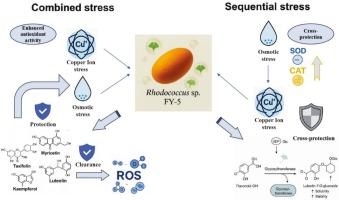Microbial flavonoids from Rhodococcus sp. FY-5 as functional substitutes for Ginkgo biloba leaf flavonoids under salt–copper stress
IF 6.8
1区 农林科学
Q1 FOOD SCIENCE & TECHNOLOGY
Innovative Food Science & Emerging Technologies
Pub Date : 2025-08-26
DOI:10.1016/j.ifset.2025.104178
引用次数: 0
Abstract
Microbial-derived flavonoids are emerging as sustainable alternatives to plant polyphenols due to their potent antioxidant activities, structural similarity to plant metabolites, and scalability via fermentation. This study investigated the stress-induced metabolic responses of Rhodococcus sp. FY-5 (an endophyte from Ginkgo biloba) and evaluated the functional attributes of flavonoid extracts obtained under three conditions: ERF (Endophytic Rhodococcus sp. FY-5 flavonoids), NSCF (NaCl sequential Cu2+ stress flavonoids), and NCCF (NaCl combined Cu2+ stress flavonoids). Targeted LC-MS/MS profiling revealed distinct, strategy-dependent biosynthetic outputs. Compared with ERF, NCCF exhibited a 45.8 % increase in total flavonoid yield and a 62.3 % higher flavonol content, including myricetin and quercetin. Several major flavonoids in NCCF, such as quercetin, kaempferol, and rutin, matched those abundant in Ginkgo biloba leaves, indicating a comparable compositional profile. NCCF also enhanced 2,2-diphenyl-1-picrylhydrazyl (DPPH) radical scavenging activity by 38.7 %, and 2,2′-azino-bis(3-ethylbenzothiazoline-6-sulfonic acid) (ABTS) radical cation scavenging activity by 42.0 %, while reducing intracellular reactive oxygen species (ROS) levels by 35.2 %. Correspondingly, the activities of superoxide dismutase (SOD), catalase (CAT), and glutathione peroxidase (GSH-Px) rose by 29.4 %, 33.1 %, and 31.8 %. Relative to NCCF, NSCF further increased SOD, CAT, and GSH-Px activities by 41.5 %, 36.4 %, and 28.7 %, although the ROS clearance capacity was comparatively lower under NSCF. These consistent trends across metabolite profiles, antioxidant activities, and enzymatic defenses indicate the robustness of the observed stress-induced metabolic reprogramming in Rhodococcus sp. FY-5, which was stably maintained throughout the experimental period. This provides a viable approach to tailor microbial flavonoid profiles with enhanced oxidative protection and antimicrobial potential for functional food and nutraceutical applications.

红球菌FY-5微生物类黄酮在盐铜胁迫下作为银杏叶类黄酮的功能性替代品
微生物衍生的黄酮类化合物因其强大的抗氧化活性、与植物代谢物的结构相似性以及通过发酵的可扩展性而成为植物多酚的可持续替代品。研究了银杏内生红球菌FY-5在胁迫诱导下的代谢反应,并评价了在ERF(内生红球菌FY-5黄酮类化合物)、NSCF (NaCl顺序Cu2+胁迫黄酮类化合物)和NCCF (NaCl复合Cu2+胁迫黄酮类化合物)3种条件下获得的黄酮类化合物的功能属性。靶向LC-MS/MS分析揭示了不同的、依赖于策略的生物合成输出。与ERF相比,NCCF的总黄酮产量提高了45.8%,黄酮醇含量(包括杨梅素和槲皮素)提高了62.3%。NCCF中几种主要的黄酮类化合物,如槲皮素、山奈酚和芦丁,与银杏叶中丰富的黄酮类化合物相匹配,表明了相似的成分特征。NCCF还使2,2-二苯基-1-picrylhydrazyl (DPPH)自由基清除能力提高38.7%,2,2 ' -氮基-双(3-乙基苯并噻唑-6-磺酸)(ABTS)自由基阳离子清除能力提高42.0%,同时使细胞内活性氧(ROS)水平降低35.2%。超氧化物歧化酶(SOD)、过氧化氢酶(CAT)和谷胱甘肽过氧化物酶(GSH-Px)活性分别提高了29.4%、33.1%和31.8%。与NCCF相比,NSCF进一步提高了SOD、CAT和GSH-Px活性,分别提高了41.5%、36.4%和28.7%,尽管NSCF对ROS的清除能力相对较低。这些在代谢物谱、抗氧化活性和酶防御方面的一致趋势表明,观察到的应激诱导红球菌FY-5代谢重编程的稳健性,并在整个实验期间稳定维持。这为功能性食品和营养保健应用提供了一种可行的方法来定制具有增强氧化保护和抗菌潜力的微生物类黄酮谱。
本文章由计算机程序翻译,如有差异,请以英文原文为准。
求助全文
约1分钟内获得全文
求助全文
来源期刊
CiteScore
12.00
自引率
6.10%
发文量
259
审稿时长
25 days
期刊介绍:
Innovative Food Science and Emerging Technologies (IFSET) aims to provide the highest quality original contributions and few, mainly upon invitation, reviews on and highly innovative developments in food science and emerging food process technologies. The significance of the results either for the science community or for industrial R&D groups must be specified. Papers submitted must be of highest scientific quality and only those advancing current scientific knowledge and understanding or with technical relevance will be considered.

 求助内容:
求助内容: 应助结果提醒方式:
应助结果提醒方式:


